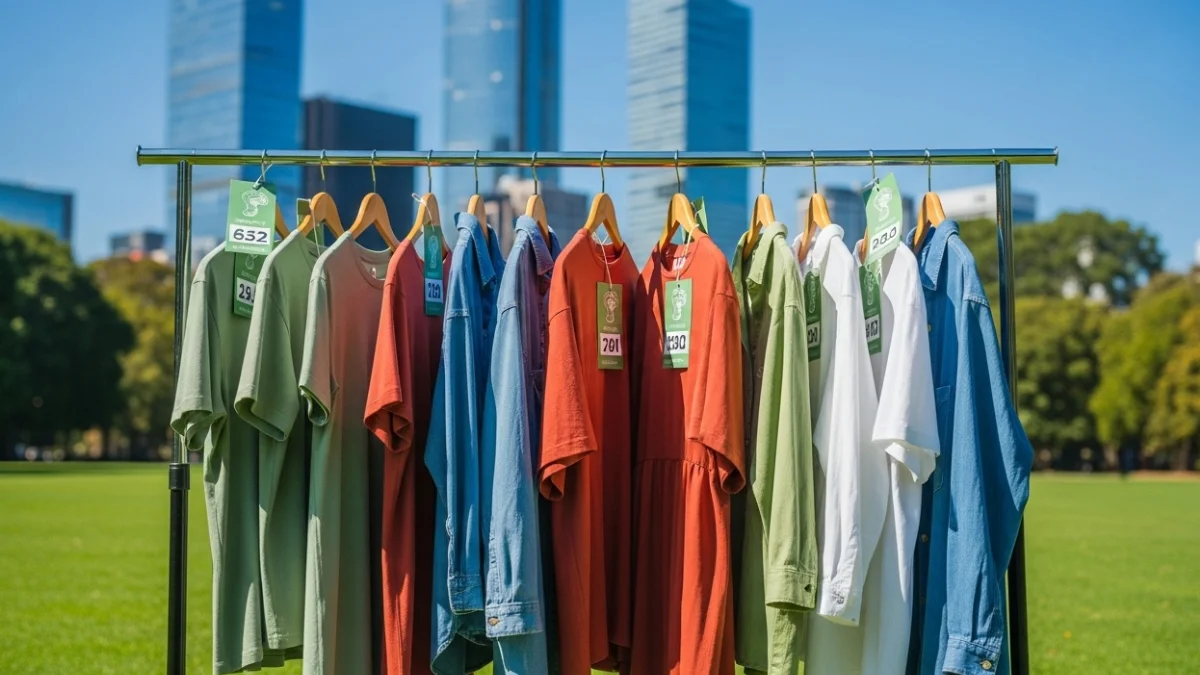The fashion carbon footprint is a big concern for our planet today. This term means all the greenhouse gas emissions linked to making and using clothes. From raw materials to your closet, every step has an impact on our climate. In this guide, we will explore what makes up fashion’s emissions, how large they are, and how both brands and consumers can reduce them.
What Is the Fashion Carbon Footprint?
The fashion carbon footprint is the total amount of greenhouse gases produced throughout the lifecycle of clothing. This includes emissions from fibre production, dyeing, manufacturing, shipping, washing, and disposal. It covers direct emissions (Scope 1 and 2) and indirect emissions (Scope 3) which happen in supply chains. Understanding these emissions helps brands and consumers take meaningful climate action.
Definition and Components
When we talk about the fashion carbon footprint, we mean every stage from seed to store. It involves raw material extraction, textile production, finishing, transport, use, and end-of-life treatment. Each of these stages adds carbon dioxide and sometimes methane to the atmosphere. Recognizing all these parts makes it easier to target the biggest sources of emissions.
Lifecycle Emissions in Fashion
Lifecycle emissions are the combined greenhouse gases produced from a garment’s birth to its end. This includes growing fibres, spinning yarn, weaving fabric, dyeing, sewing, and transporting clothes worldwide. Even washing and drying garments at home adds emissions over time. Looking at the entire lifecycle gives a more honest picture of the fashion industry’s climate impact.
How Big Is the Fashion Industry’s Carbon Emissions?

The global fashion industry is responsible for a large share of greenhouse gas emissions worldwide. Estimates put it at 8–10% of all emissions, which is more than international flights and maritime shipping combined. These numbers are rising with the growth of fast fashion and increased clothing consumption. Understanding the scale of the problem is the first step toward change.
Global Statistics and Recent Reports
Recent reports show fashion emits between 2.1 and 2.5 billion tons of CO₂ annually. This figure includes everything from raw material production to end-of-life disposal. The numbers vary because of different measurement methods, but they all indicate a serious climate burden. Without action, emissions could rise by 50% by 2030.
Carbon Emissions of Fast Fashion Versus Slow / Sustainable Fashion
Fast fashion produces more emissions because it relies on cheap materials, rapid production, and global shipping. Clothes are worn fewer times, increasing the impact per wear. Slow or sustainable fashion uses better materials and encourages long-term use, reducing lifecycle emissions. Choosing quality over quantity helps cut your personal carbon footprint.
Emission by Material
Different materials have very different carbon footprints. Polyester, a synthetic fibre, has high emissions because it comes from fossil fuels. Cotton can also be emission-heavy due to water use and fertilisers, while recycled fibres have a lower impact. The table below compares the average carbon emissions of common fabrics per kilogram:
| Material | Average CO₂ Emissions (kg per kg of fibre) | Notes |
|---|---|---|
| Polyester | 9.5 | Derived from fossil fuels, high energy in production |
| Conventional Cotton | 5.9 | Fertiliser and irrigation raise emissions |
| Organic Cotton | 3.8 | Lower input, less fertiliser but lower yields |
| Wool | 24.0 | Methane from sheep greatly increases impact |
| Recycled Polyester | 4.5 | Uses existing plastic bottles, less energy needed |
This table helps you see how material choice affects the fashion carbon footprint.
Major Sources of Fashion’s Carbon Footprint
Fashion’s emissions come from multiple stages of the clothing lifecycle. These include raw materials, textile manufacturing, dyeing, transportation, consumer use, and disposal. Each stage contributes differently, but together they create a large climate impact. Identifying these sources shows where we can act.
Raw Material Extraction and Fibre Production
Producing fibres such as cotton, polyester, and wool accounts for a significant share of emissions. Fossil-fuel based fibres like polyester release carbon during production. Agricultural fibres use fertilisers and water, generating nitrous oxide and other greenhouse gases. Moving to recycled or plant-based alternatives can lower emissions.
Dyeing, Finishing, Manufacturing Energy Use
Dyeing and finishing textiles require lots of hot water, steam, and chemicals. Factories often rely on coal or gas energy, which adds significant carbon emissions. Switching to renewable energy and cleaner processes can reduce the climate impact of these stages. Innovations like digital printing and waterless dyeing are promising steps.
Transportation and Global Supply Chains
Fashion supply chains are global, moving fabrics and finished goods across continents. Air freight, ships, and trucks all add emissions to the product footprint. Consolidating shipments, using low-carbon fuels, and nearshoring production can help. Even packaging choices affect transportation efficiency.
Consumer Use (Washing, Drying, Ironing)
How we care for our clothes matters for emissions. Washing with hot water, tumble drying, and frequent ironing all consume energy and add to carbon footprints. Washing less, using cold water, and air drying can cut these emissions drastically. Educating consumers about garment care is a low-cost way to reduce impact.
Disposal / Waste, Landfill, Textile Recycling
When garments are thrown away, they may end up in landfills or incinerators. Decomposing textiles can release methane, especially blends with natural fibres. Recycling or reusing textiles keeps them out of landfills and saves raw materials. Brands can set up take-back programs to help.
Challenges & Barriers to Reducing Emissions

Reducing fashion’s carbon footprint is not simple. It requires transparency, data, technology, and behaviour change. Many brands face obstacles in measuring and cutting emissions. Understanding these barriers can lead to better solutions.
Lack of Transparency in Supply Chain
Most fashion brands have complex global supply chains with many tiers of suppliers. This makes it hard to track energy use and emissions. Without reliable data, it is difficult to set realistic targets. Better reporting and certification systems are needed.
Measurement Difficulties (Scope 3, Data Gaps)
Scope 3 emissions are usually the largest part of a brand’s footprint but also the hardest to measure. Suppliers may not track or share data, leading to gaps and underestimates. Tools and collaborations can improve accuracy. Consistent methodologies will help compare progress across brands.
Cost & Technology Constraints for Sustainable Materials
Low-carbon materials and cleaner technologies can be more expensive initially. Small brands may lack funds to invest in them. Governments and investors can provide incentives and support. Over time, scaling up green technologies can reduce costs.
Consumer Behaviour & Awareness Challenges
Even if brands improve, consumers’ choices still matter. Frequent buying, quick disposal, and poor garment care add to emissions. Raising awareness about sustainable consumption helps bridge this gap. Brands can engage customers with education and incentives.
How to Reduce the Fashion Carbon Footprint
There are many ways both brands and individuals can act. Industry-level changes can make big emissions cuts, but consumer behaviour also matters. Combining both will bring the best results. Here are some key strategies.
Industry / Brand-Level Strategies
-
Use renewable energy in factories and offices to cut Scope 2 emissions.
-
Source low-carbon materials such as organic cotton or recycled polyester.
-
Adopt circular economy models with take-back, resale, and upcycling programs.
-
Innovate in dyeing and manufacturing using waterless or low-energy processes.
-
Set science-based targets and support regulations for climate action.
What Consumers Can Do
-
Buy less, buy better: Choose quality pieces you’ll wear many times.
-
Choose more sustainable materials: Check labels for organic or recycled content.
-
Care for garments well: Wash in cold water, air dry, and repair clothes.
-
Support transparent brands: Look for companies with sustainability reports.
-
Recycle and donate: Keep clothing out of landfills by reselling or donating.
Case Studies & Recent Innovations
Many brands are making progress to cut their carbon footprints. They show that real change is possible with commitment and creativity. Highlighting these examples inspires others to follow.
Examples of Brands Reducing Their Footprint
Some global brands have switched to 100% renewable energy in their operations. Others have increased the share of recycled fibres in their collections. Take-back programs and resale platforms are becoming more common. These actions show a pathway for the rest of the industry.
New Material Innovations or Processes
Start-ups are creating low-carbon fibres from agricultural waste, algae, and even lab-grown materials. Digital printing reduces water and energy use compared to traditional dyeing. New logistics models reduce empty shipping space. These innovations help bring emissions down across the supply chain.
Regulatory / Policy Success Stories
International efforts like the UN Fashion Industry Charter for Climate Action set common goals. Some countries are introducing extended producer responsibility laws for textiles. These regulations push companies to measure and reduce their emissions. Policy support is key to scaling up sustainable practices.
Future Outlook & Trends

The future of fashion can be more sustainable if all stakeholders act. Net-zero targets, better measurement, and consumer demand are shaping the industry. Here’s what to watch.
Net-Zero Goals in Fashion (Industry Charters, Global Targets)
Many large brands have pledged to reach net-zero emissions by 2050 or earlier. Industry groups and charters provide frameworks and shared tools. Progress is uneven but accelerating. These commitments signal a shift from talk to action.
Emerging Metrics & Measurement Tools
New tools allow more precise tracking of carbon footprints, including methane and other gases. Blockchain and digital product passports can improve data transparency. Lifecycle analysis (LCA) is becoming standard practice. Better data leads to better decisions.
Consumer & Market Trends
Consumers are more aware of fashion’s environmental impact than ever. Resale, rental, and repair services are growing fast. Sustainable fashion brands are attracting loyal customers. These trends can push the mainstream industry toward lower emissions.
Conclusion
The fashion carbon footprint covers every stage of a garment’s life, from fibre to disposal. It is a major contributor to global greenhouse gas emissions but can be reduced with the right actions. Brands, governments, and consumers each have a role to play in creating a more sustainable fashion future. By understanding and addressing the problem, we can dress ourselves without dressing down the planet.

